Brussels fashion pioneer Sonja Noël is celebrating forty years of STIJL this month, with a retrospective exhibition at the Fashion & Lace Museum. Since opening her eponymous boutique in 1984, Noël has launched numerous Belgian talents, such as Marina Yee and Martin Margiela, enriching the entire Dansaert district. In four contemporary silhouettes, she looks back on her career.
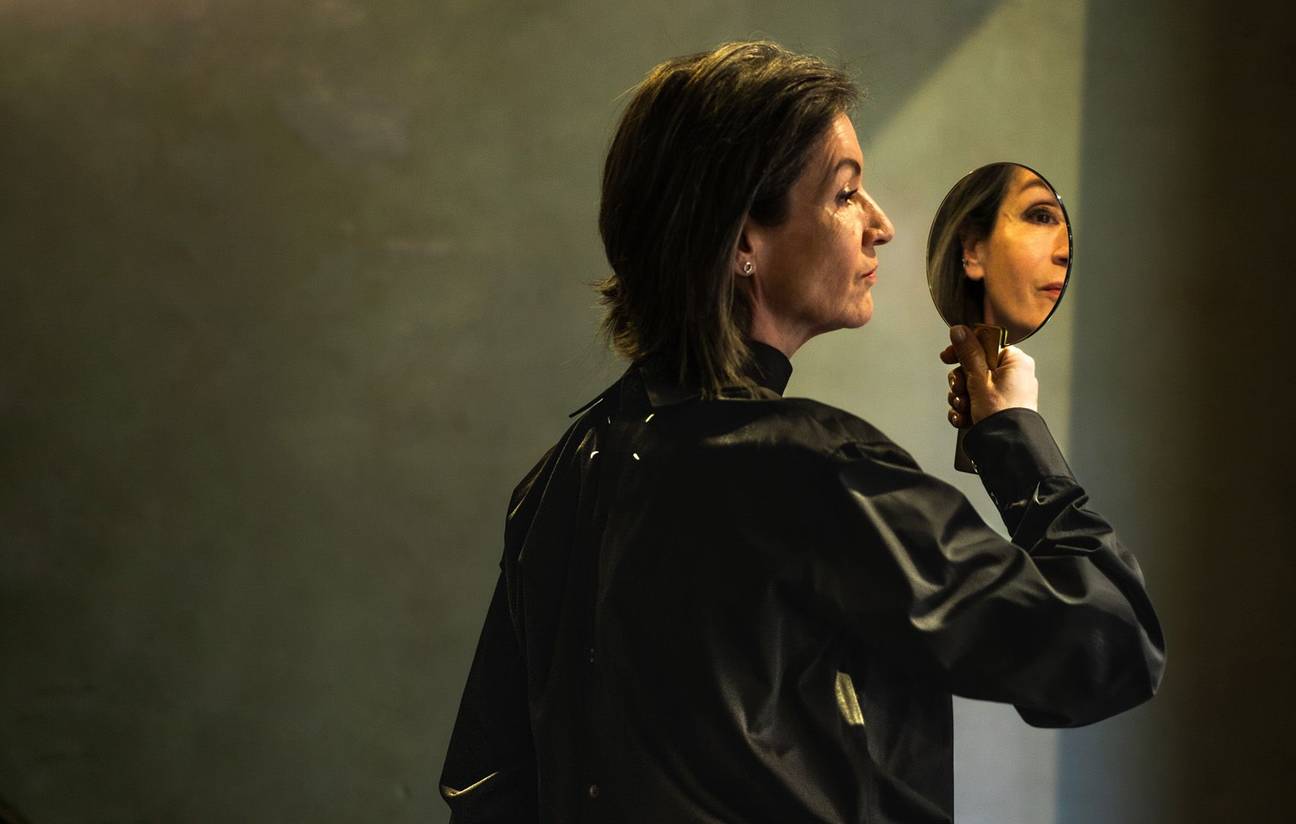
©
Sophie Soukias
"Everything moves fast in fashion. You work from season to season, you look ahead, and always seek improvement. I can’t even believe I’ve been doing this for forty years,” says Sonja Noël. Nevertheless, in September 2024, STIJL, her fashion boutique on the Antoine Dansaertstraat/Rue Antoine Dansaert, celebrated its fortieth anniversary. Realisation sunk in, and in consultation with the city of Brussels, the idea for a retrospective exhibition was born. Noël searched the archives of major fashion houses for over sixty outfits that typify the history of STIJL and her vision of fashion. Her daughter, Aya Noël, curated these into a thematic show.
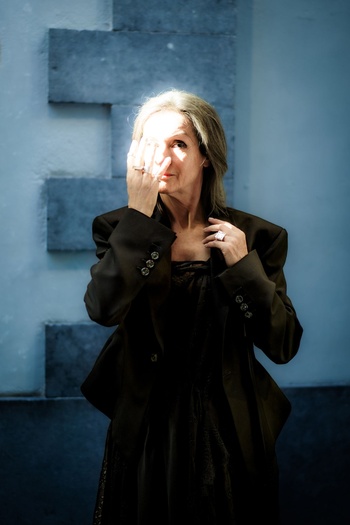
©
Sophie Soukias
“They are all strong pieces that were once in the shop. We’re not presenting them chronologically, but by theme. Such as deconstruction, Martin Margiela’s trademark,” says Noël. More on that Belgian avant-gardist later. First, Sonja Noël wants to catch her breath. She has just returned from Paris, where the Fashion Week inaugurates the orders for autumn. “I have to set up the spring collections in the shop and at the same time, finish the exhibition,” she says. “We’ve stripped the Fashion & Lace Museum down to an industrial, minimalist space in the spirit of STIJL. The glass tiles from my first shop also found their place there.”
And so we come to the beginning. On September 27, 1984, Sonja Noël, then just 23 and newly graduated as an art historian, opened her own boutique on Antoine Dansaertstaat/Rue Antoine Dansaert 26. A year later, in December 1985, Noël and her boyfriend at the time, Walter De Weerdt, opened a men’s store, STIJL+, two doors down, followed, in 1987, by the lingerie store Underwear at number 47. Gradually, Noël, along with other pioneers, transformed the Dansaert district into a trendy fashion district. It even gained international recognition when Martin Margiela’s very first brand store opened there in 2002, in a corner building – again – owned by Noël on the Vlaamsesteenweg/Rue de Flandre.
“People buy fewer clothes than before, but that’s the case everywhere, not just in Brussels,I must say that my shop benefits a little from that. Perhaps people don’t go shopping every weekend anymore, but they do think about it longer or buy one special piece per season.”
However, the fall of the neighbourhood is as well-known as its rise. In 2019, the Margiela store closed due to disappointing sales figures, followed by the challenging Covid years. Chains and restaurants filled the gaps. “People buy fewer clothes than before, but that’s the case everywhere, not just in Brussels,” says Noël now. “I must say that my shop benefits a little from that. Perhaps people don’t go shopping every weekend anymore, but they do think about it longer or buy one special piece per season.”
And then there are the collectors. “When I first came here years ago, I didn’t have much money. Mrs. Noël recommended pieces to me that my daughter still wears now,” says a lady who just came to pick up her order. “A true collector,” Noël calls her afterwards. “This is her art world. Just as other people would buy timepieces or paintings, she buys clothing. Fashion is still an accessible form of art. What a joy to be able to wear that every day.”
.
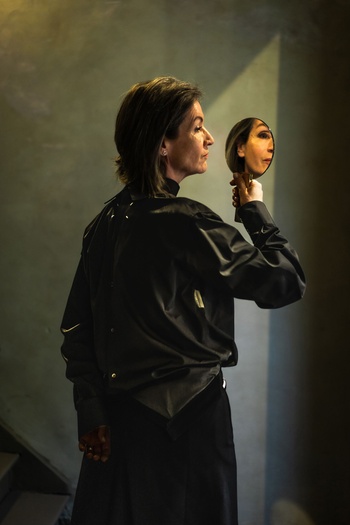
©
Sophie Soukias
Maison Margiela
‘His surreal side suits Brussels well’
A dress made from an unzipped pencil skirt and a men’s shirt worn backwards: in Maison Margiela’s summer collection, deconstruction remains the key word. “Martin Margiela has always given clothing a new meaning. He turns pieces around, inverts them, or unstitches the seams,” says Noël. “His first collection in 1988 already included a sweater made from cut-up army socks. I missed that show because I was giving birth to my first son, but I travelled to Paris as soon as I could. With a baby.”
The rest of the story is history: Noël bought the collection from Martin Margiela, the brand that the Genk native had only just founded with Brussels designer Jenny Meirens. “And it caught on. By the 2000s, Martin Margiela had expanded to include a men’s line, a shoe line, and an artisanal collection. The brand store on Vlaamsesteenweg/Rue de Flandre grew into a phenomenon and attracted people from abroad,” says Noël. “Unfortunately, Belgians were less fond of John Galliano’s taste.” The Englishman took over creative direction from Margiela and Meirens in 2014. “I think he did a fantastic job, with the same ideas of deconstruction, but with his own DNA and more exclusive pieces. But with that alone, the shop couldn’t survive.”
The dress in the photo is one of the last by Galliano for Maison Margiela. This year, Belgian Glenn Martens takes over as artistic director. “Fantastic. We’ve been selling his pieces for ten years, he is a wonder boy,” says Noël. And there’s also the necessary magic between the brand itself and the Dansaert district. “The surreal side, the casualness, not taking itself too seriously: that typifies Margiela just as much as Brussels.”
Under her dress, Noël wears patent leather boots with a kitten heel. “Very punky and yet elegant.” Is that 1980s punk still in her style today? “Maybe. I experienced a great freedom of thought when I was young. Anything was possible. Today, I find young girls too well-behaved. Among young twenty-somethings, I do see a shift. Those who shop in vintage stores are more creative with combinations. They come here for inspiration, and buy one special item as soon as they have money.”
.
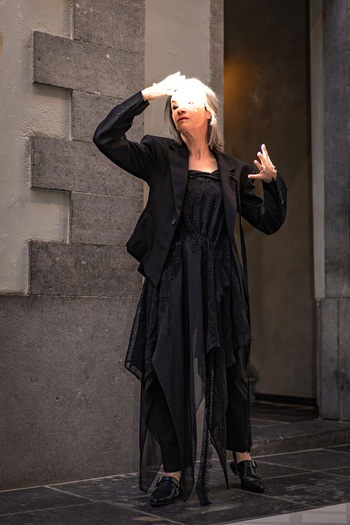
©
Sophie Soukias
Ann Demeulemeester
‘Androgynous, sensual, and poetic. I’m like that too’
A tailored men’s jacket and narrow black trousers. “The cut is almost historical, in the dark, glamorous aesthetic of Ann Demeulemeester,” says Sonja Noël about her second ensemble. Over the trousers, she wears a transparent dress with lace and embroidery. Sleeves and symmetry are nowhere to be found. “That’s how young girls wear it now, isn’t it? Bare breasts under a see-through top. I feel a bit too old for that,” she laughs.
Ann Demeulemeester has been a mainstay at STIJL since the 1990s. “Along with Dries Van Noten, it’s one of my main brands. The fragile, sensual, and poetic side, but also the masculine, androgynous side are typical for her, and I’m like that too. Her pieces last for years, because each collection logically follows the previous one,” says Noël.
Since 2020, Italian Claudio Antonioli has been designing the collections; Demeulemeester sold her brand back in 2013. The characteristic black has never left. Good news for the fans, because black is making a comeback in fashion. “After Covid, we had years of lots of colour and prints, but that’s long gone. We’re getting dark colours again, but with totally new shapes and fabrics,” says Noël. “Never say never in fashion. Short, long, tight leggings or looser again: I’ve seen it all. And of course, I have my own style, but I’ll go with the flow in fashion.”
.
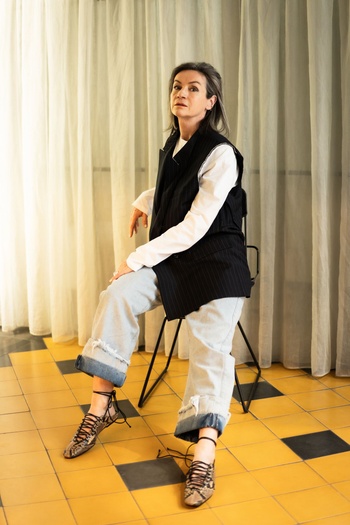
©
Sophie Soukias
Marina Yee
‘Flamboyant multi-talent and good friend’
A sleeveless jacket over casual jeans and a white oversized T-shirt. Sonja Noël has supported her good friend Marina Yee since the opening in 1984. That same year, the two met at the presentation of a Belgian prize for promising designers. “She didn’t win it then, but I thought her style was fantastic. Back then, Marina was a free-spirited lady with long blonde hair, lots of mascara, and vintage cowboy boots. She wore very short skirts with men’s jackets over them. She has always maintained that flamboyant style. I bought her collection right away,” says Noël.
Yee had just graduated in Antwerp and was friends with Ann Demeulemeester, Dries Van Noten, Walter Van Beirendonck, Dirk Van Saene, and Dirk Bikkembergs: the Antwerp Six. “Marina was my introduction to Antwerp. She went to Paris for a while, but returned disillusioned to Brussels in 1992,” says Noël. Yee opened a tea room in the Marollen/Marolles and lived for a long time on the Varkensmarkt/Rue du Marché aux Porcs, close to Noël. “Our children played together, and she was a well-known face in the neighbourhood. She taught at fashion academies, but whenever she made a collection in between, I would sell it.” Just as her contemporaries are leaving the fashion world behind, Yee is experiencing a comeback. “During Covid, she picked up her old ideas again. She does everything on her own, and yet she’s in the best shops worldwide,” says Noël, who, just like Yee, is not thinking of stopping yet. “Because I love discovering new names and meeting customers. So the exhibition is not a farewell. On the contrary, I’m doing it to give a new impulse to my business and the entire Dansaert district.”
.
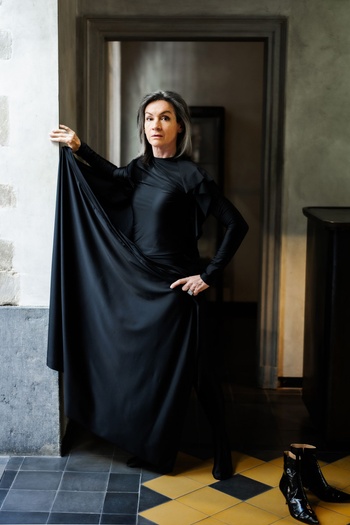
©
Sophie Soukias
Marie Adam-Leenaerdt
‘Unique young talent from Brussels’
”This is my ideal dress. I can work in the shop with it, then do my yoga at home, lie on the sofa, and afterwards go to a nice cocktail party. Without a crease,” says Sonja Noël. Her wonder dress is designed by Brussels native Marie Adam-Leenaerdt, barely 29 and already a finalist last year for the prestigious LVMH Prize for Young Fashion Designers. “She is enormously ambitious,” says Noël. “I was the first to order her collection in her small studio in Etterbeek. Her pieces have an aura about them that transcends the ordinary.”
Marie Adam-Leenaerdt is the latest talent that Noël has launched, just as she did forty years ago with Martin Margiela, and throughout the years in numerous graduation juries or consultancy assignments. “As soon as I had placed my order, the best producers and patrons in the fashion industry rallied behind her. As a beginner, you need friends, family, and investors.”
Choosing such beginners is also a risk for Noël. “You rarely earn back a collection after one season; I calculate that in the long term. But I’ve certainly made mistakes in my career.” Like her own bridal salon, which she had to close after a year. “It didn’t suit me. I now consciously skip brands more often. Not because I think they’re bad, but because they don’t always fit in the shop.”
Adam-Leenaerdt’s style does, Noël believes, partly because of the similarities with Margiela. Moreover, she is a product of La Cambre, the Brussels school whose alumni have grown into artistic directors of major Parisian houses like Chanel and Yves Saint Laurent. “But as a designer, you need more than a good education. There are simply too many clothes in the world, and it’s hard to compete with that.”
It makes it even more unique that Adam-Leenaerdt is already showing in Paris. “She works very hard, with a great desire to grow. I look forward to her future.” That forward-looking gaze also graces the exhibition poster: a model poses in an oversized jacket by Adam-Leenaerdt. Black, masculine, a touch of vintage, and yet sensual. Where have we heard that before? In forty years, you don’t have to change everything.
Read more about: Brussel , Expo , Mode , belgische mode , Mode & Kant Museum




Fijn dat je wil reageren. Wie reageert, gaat akkoord met onze huisregels. Hoe reageren via Disqus? Een woordje uitleg.